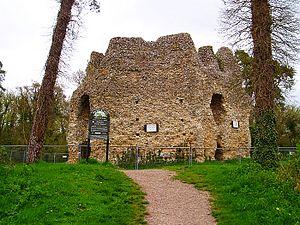- Odiham Castle
-
Odiham Castle Part of Hampshire Odiham, England 
The inner octagonal shell keep of Odiham Castle.Type Shell keep with outer bailey Built 1207 - 1214 Built by King John Construction
materialsFlint
Lime Mortar
TimberHeight Up to 9 metres (30 ft) In use Until mid 16th century Current
conditionRuin Current
ownerHampshire County Council Open to
the publicYes Battles/wars First Barons' War Events Hosted Parliament in the 13th Century
Prison of Scottish King David IIOdiham Castle (also known locally as King John's Castle) is a ruined castle situated near Odiham in Hampshire, United Kingdom. It is one of only three fortresses built by King John during his reign.
The site was possibly chosen by King John because he had visited the area in 1204 and it lay halfway between Windsor and Winchester.
Contents
Construction
Odiham Castle was built on 20 acres (81,000 m2) of land acquired from local lord, Robert the Parker; utilising a modified bend of the River Whitewater.
The castle, which took seven years to complete, had a two-storey stone keep and a square moat. There were also raised banking and palisades. Notably the stronghold also had a domus regis or 'king's house'.
Scrolls held in the public records office reveal that total expenditure between 1207 and 1214, when work ceased, amounted to £1,000 (equivalent of £11.4m in 2009).
History
In 1215 it was from either Odiham or Windsor that King John rode out to Runnymede where met he met the barons and signed the Magna Carta. A year later Odiham Castle was captured by the French after a two-week siege during the First Barons' War in 1216.
Odiham Castle might have become one of the most important strongholds in England. In 1238 Simon de Montfort married King John's daughter Eleanor just two years after she had been granted Odiham by her brother, King Henry III. However de Monfort rebelled against Henry and died at the Battle of Evesham in 1265 and Eleanor was exiled. Odiham Castle was again retained by the Crown.
The castle was also involved in the rebellion led by the powerful Despenser family against Roger Mortimer and Queen Isabella of France, the wife of Edward II.
During the fourteenth century Odiham hosted Parliament. Scottish King David II, after his capture at the Battle of Neville's Cross in 1346, was also imprisoned here for 11 years. However he was held under light guard and was allowed to keep a household.
By the 15th century Odiham was now used only as a hunting-lodge. In 1605 the former royal castle was described as a ruin.
Present day
Odiham Castle is open to the public. The only visible remains are part of the octagonal keep and outlying earthworks. In September 2007 Hampshire County Council undertook a restoration of the shell keep under guidance from English Heritage.
Gallery
Restoration
Restoration work began in September 2007 to consolidate the ruins and carry out extensive work on improving the site.[1]
Further reading
- MacGregor, Patricia (1983), Odiham Castle, 1200–1500: Castle and Community, Sutton, ISBN 0862990300
References
- ^ Hampshire County Council (2006). "Odiham Castle". Countryside Service. http://www3.hants.gov.uk/hampshire-countryside/odiham-castle.htm. Retrieved 2007-12-07.
External links
Coordinates: 51°15′41.11″N 0°57′42.20″W / 51.2614194°N 0.961722°W
Categories:- Castles in Hampshire
- Visitor attractions in Hampshire
- Grade I listed buildings in Hampshire
- Ruins in Hampshire
Wikimedia Foundation. 2010.


